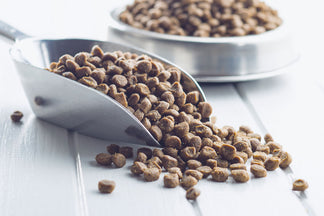One of my pet peeves regarding pet food is the online reviews. Over the years, I have stumbled upon these reviews while collecting data and doing research on pet food ingredients, calories and macronutrients. To illustrate the problem with online reviews, I will use a dog food recipe produced by a popular pet food brand.
First, let’s look at the overall rating and sample a few reviews from the brand's site.
The overall rating is 4.5 out of 5 stars based on 75 reviews. As an added validation, 69 out of the 75 reviewers would recommend this product. Pretty convincing data from the masses. Digging further, here are 2 of the reviewer comments:
Healthy Choice! My dog loves this dry food! It obviously has very good, tasty flavor!
“Dogs LOVE IT! I have 3 Great Danes and they love this food. They are pretty picky eaters but I have no trouble getting them to eat this. It is also very good for them.”
Based on this (and most of the other reviews), this food appears to be a great choice for a dog.
On Amazon, the results are similar, although there are a sprinkling of negative reviews. The Amazon reviewers rate this food a strong 4.2 out of 5 stars across 643 total reviews. Still a very high number.
But before we commit to anything, let's take one more step. Let’s look at the macronutrients and ingredients in this food.
Macronutrient Profile
This food’s guaranteed analysis is as follows:
Crude Protein: Min 23.0% Crude Fat: Min 11.0% Crude Fiber: Max 4.0% Moisture: Max 12.0%
Converting this to a dry matter basis, it's about 26% protein and 54% carbohydrate. We can see that this food’s macronutrient profile is inappropriate for a dog or cat. Why wasn't this mentioned in the reviews?
Ingredients
Here is the ingredient list for this food:
Ground Whole Grain Corn, Poultry By- Product Meal (Source Of Glucosamine And Chondroitin Sulfate), Brewers Rice, Corn Gluten Meal, Ground Whole Grain Wheat, Animal Fat (Source Of Omega 6 Fatty Acids [Preserved With Bha And Citric Acid]), Soybean Meal, Chicken, Dried Plain Beet Pulp, Natural Flavor (Source Of Meatier Flavor), Fish Oil (Preserved With Mixed Tocopherols), Salt, Monocalcium Phosphate, Meat And Bone Meal (Source Of Calcium), Potassium Chloride, Calcium Carbonate, Dried Peas, Vitamin E Supplement, Zinc Sulfate, Choline Chloride, Niacin [Vitamin B3], Biotin, Dried Carrots, Bha & Citric Acid (A Preservative), Blue 2, Yellow 5, Yellow 6, D-Calcium Pantothenate [Source Of Vitamin B5], Riboflavin Supplement [Vitamin B2], Red 40, Pyridoxine Hydrochloride [Vitamin B6], Copper Sulfate, Potassium Iodide, Vitamin A Supplement, Thiamine Mononitrate [Vitamin B1], Vitamin D3 Supplement, Vitamin B12 Supplement, Folic Acid
Corn, rice, and wheat dominate the list—this food is full of cheap fillers. Furthermore, it contains “poultry by-product meal” (Really?), “animal fat” (What kind of animal?), “meat and bone meal” (What kind of meat?), the artificial preservative BHA, and four different artificial colorings. By my analysis, this can't possibly be a 4-out-of-5 star dog food.
One other point worth making is specific to the contents of online reviews. Many reviews seem to focus on the fact that their dog “loves the food,” which doesn't tell us much. A food that your dog “loves” does not translate to a good product. To use a human analogy, if you gave your 8 year old a choice between spinach and ice cream, which do you think they would choose? Likewise with many dogs and cats, they will eat foods that are sweetened or contain added (and often unnatural) flavor enhancers.
The moral of this story: you can’t trust consumer reviews that are published on the web. At times, they can provide a good indication of a pet foods quality, but we must look more closely at the product ourselves, rather than the ratings and comments.

 Food
Food
 Food
Food
 Food
Food
